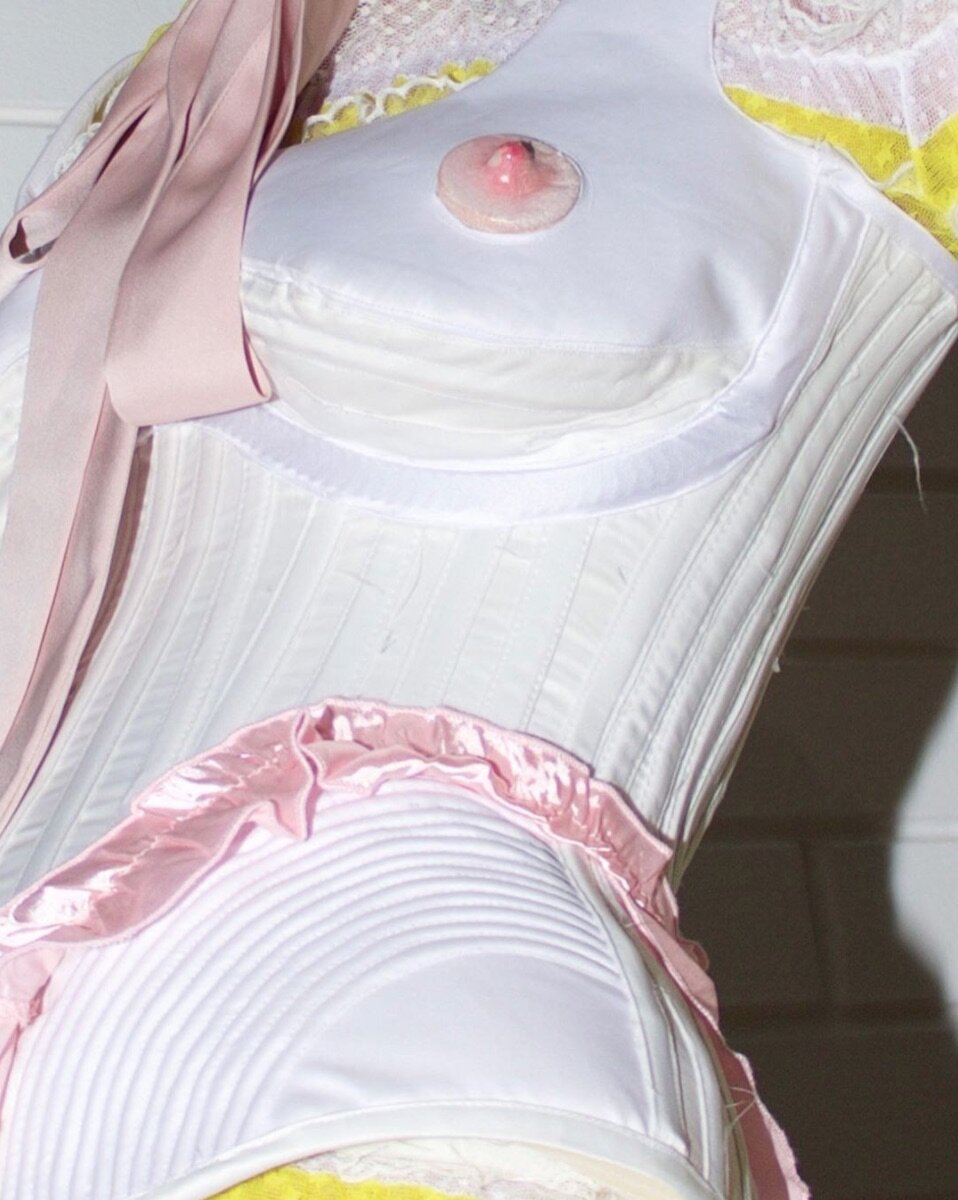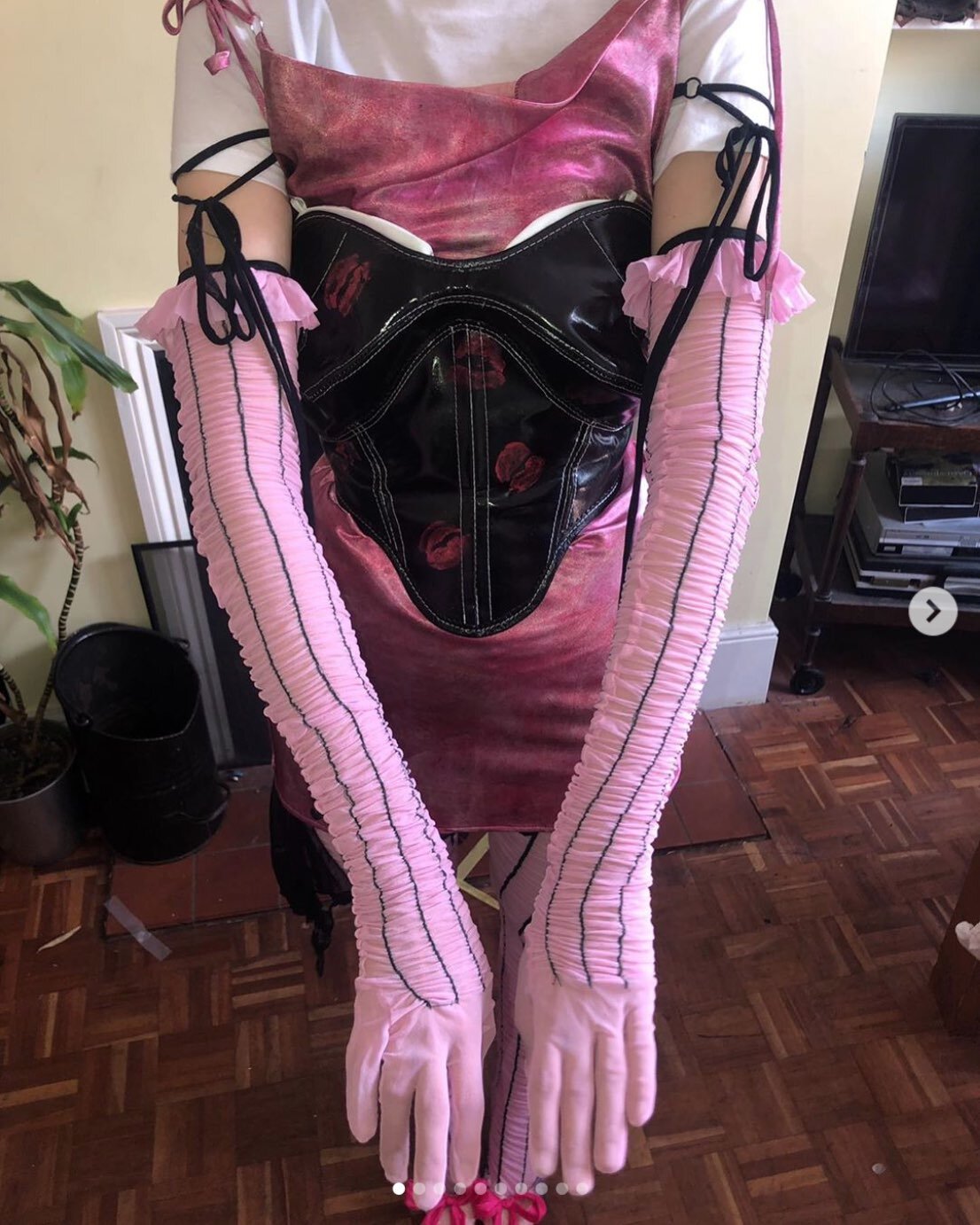Fabian Kis-Juhasz
Ruffled silk wrinkles against sagging patent leather breasts, conjuring the image of someone who is simultaneously glamourised and demonised. This is the work of Fabian Kis-Juhasz, a designer who explores femininity with academic intelligence and poetic imagination. She was obsessed with vintage horror from an early age, only to later find a connection between that horror and the social connotations of femininity. This connection has become the core of her designs, that contrast hyper-feminine puckered pink tule with horror-like corsets and eerily asymmetric cuts. Structurally, her work draws inspiration from historical garments and costumes, yet always made contemporary. Crinolines and corsets are held together by countless bows, it’s all a bit crooked and distorted yet immaculately detailed. Fabian’s designs may recall baroque aristocrats, witches or demonesses but above all they challenge our patriarchal ideas of femininity, raising the question: Why did we ever think this norm was normal?
First off, which pronouns do you prefer?
I always feel a bit uneasy about this question because I’m still in the process of coming to terms with my gender identity. In my mother tongue, we don’t have gender pronouns so it’s not something I paid attention to growing up. But, at the moment I prefer she/her.
From distorted corsets to ruffled skirts, your work plays with notions of femininity. What does femininity mean to you, personally?
I base my work on the idea that you don’t need to be feminine to be a woman and that you don’t need to be a woman to be feminine. Femininity is a fantasy, it’s a construction of demeanour and appearance that amplifies and glamorises the patriarchy. Womanhood is a multifaceted experience that is much more complex than femininity. I find femininity very comforting and something that makes me feel in touch with myself but I would never want to assign it to one gender or group of people exclusively.
Your designs balance romantic, hyper-feminine elements with eerie, horror-like distortions. How did your fascination with horror come to be?
Horror, spooky things and over-the-top femininity have always been my main interests for some reason, yet I was never able to connect the two until my masters. In high school, I saw Suspiria and discovered vintage horror, which in a way provided the “proof” of an existing interest or genre for the things I’m obsessed with. It wasn’t until I started to contextualise my work in an academic way that I started to see connections between horror and the idea of femininity in a social context. I read this book by Barbara Creed called “The Monstrous-Feminine” which is an academic text about the feared and shunned aspects of womanhood and femininity and their portrayal in horror films. It just compiled all the ideas that I had circulating in my mind for years but I lacked the vocabulary and understanding to articulate. I guess in a sense, mortality, ageing and being imperfect are the biggest enemies of femininity as they corrupt a woman’s worth (speaking in awful patriarchal terms of course) so there is something naturally horrific about being feminine and being a woman.
What I like about the corsets especially, is that they question society’s idea of what the female body should look like whilst simultaneously referencing the way powerful women were and still are perceived; as witches or demonesses. Do you often reference historical or costume elements in your designs?
Yes, I love looking at historical costumes! Studying them and all the information they provide can improve your garment construction whether or not you are interested in the social connotations of the piece. At this point I think I have a method or approach of looking at these pieces, understanding them and subverting their meaning by re-telling them in my own visual language. I like when things look a bit crooked and wrong but on closer observation, you can tell that they contain a lot of work and attention to detail. I also love the idea of re-working a piece that was historically created to cinch you in and push you up but instead it gives you the appearance of sagging breasts and lump, so basically humouring its original function.
What role do you think fashion plays in performing femininity, or gender in general - albeit consciously or unconsciously?
Definitely a huge role, it’s what shaped women’s bodies for centuries based on their perception and role in society. It’s also super intertwined with politics and religion, making it a bit hard to tell which one was first, the chicken or the egg? It’s a product of its time, a reaction to what was happening. But, it also shaped the culture of its present and future.
In that sense, your designs assert femininity as a glamour, to be put on or taken off as the wearer pleases, almost in a caricaturistic way, which altogether reminds me of drag. Do you have a link with the drag scene?
Yes, it’s definitely something I thought about before. Femininity itself is a performance so it’s essentially just drag. I hate to quote RuPaul but, “We’re all born naked and the rest is drag” sums it up pretty well. Drag is nice and entertaining but I find it so boring because it always portrays the same woman over and over again. She’s fierce and she's all that in her pumps and leotards. When I see someone like Katya from drag race it’s such a breath of fresh air, she is a mentally unstable psychotic woman who wears confused outfits. I wish she was a bit less glamorous though.
Nowadays, feminism (and challenging gender stereotypes in general) has become a fashion trend adapted by the mainstream - think “the future is female” t-shirts. What’s your opinion on this?
It is very awful and highly annoying. People will capitalise on anything if they can turn it into profit - and I don’t just mean money. I see a lot of young designers and brands who are doing it for attention, to be cool or shocking. Like, you embroidered a pair of uteruses on some knickers, now what? It had its positive effect as it made everyone more aware of feminism, which I think helped clear up the basic concept of it whilst also encouraging people in the public eye to be more active and outspoken, that was great. Ultimately, however, it’s wrong and cynical to use feminism as a vehicle to sell clothes that were made by underpaid workers, most of whom are women.
I noticed your designs are not publicly for sale yet. Is this something we can look forward to?
Yes, getting a production setup and selling is so much work and money so it takes a while. I was going to present a properly produced and priced collection at Tokyo Fashion Week this March, sadly it never came out due to the coronavirus pandemic. I’m now waiting to see what’s gonna happen and if I can present it next season. I would love to sell, but it’s hard to do it ethically while still turning a profit. Right now, I’m planning to make some of my patterns available to purchase along with a sewing tutorial so you can make them yourself at home, so stay tuned for that!
courtesy FABIAN KIS-JUHASZ
interview MARJOLIJN OOSTERMEIJER
What to read next

















